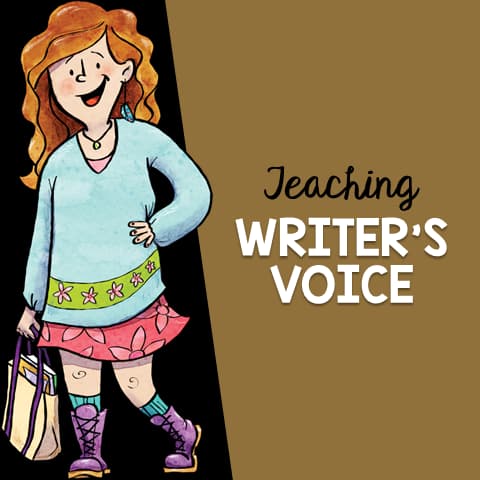
Need a quick way to teach writer’s voice that actually sticks? Between quirky mentor texts, engaging examples, and one hilariously earnest Ed Sheeran commercial, this post gives students real insight—and it’s ready for Monday. Plus, grab the free handout to make lesson planning easy. It includes the printables you need to complete the activities mentioned in the post.
🤔 What Is Writer’s Voice Anyway?
A writer’s voice is like a fingerprint made out of words. It’s the distinct way someone puts sentences together, chooses vocabulary, and sprinkles in personality.
Think:
- formal vs. casual
- long flowing prose vs. short punchy fragments
- playful, serious, snarky, poetic—it’s all in the style
In short, voice = the writer’s personality on the page.
🎭 Voice vs. Tone: What’s the Difference?
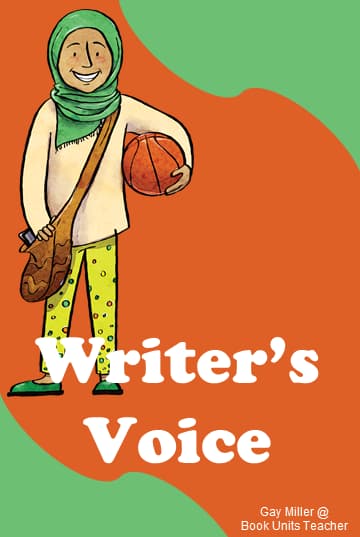
Let’s break this down with a little parent-inspired analogy (because who hasn’t experienced both ends of the look?):
- Voice = how your parent typically sounds (same phrases, same speaking style)
- Tone = how your parent feels when talking to you (cheerful? disappointed? suspicious because the chores aren’t done?)
Both matter—but tone changes depending on emotion. Voice is the consistent soundtrack.
✨ Examples in Action
Greetings that show VOICE
- “How have you been doing?” (formal)
- “Why, sugar! How’s it going?” (colloquial southern charm)
- “What’s up?” (casual)
Greetings that show TONE
- “Hey, man! Long time—no see!” (happy, excited)
- “I’ve been so worried about you. Are you okay?” (concerned)
 Writer’s Voice in Real Life: A Quick Anecdote
Writer’s Voice in Real Life: A Quick Anecdote
Writer’s voice isn’t just for books and blog posts—it sneaks into everyday moments, too.
When my son took a photography class, he wanted to try one of my old 35mm film cameras so he could learn all the manual settings. I showed him a drawer filled with vintage options, and he picked the one he thought looked coolest. A couple of days later, he said:
“Mom, this camera doesn’t work. Is it maybe the one you accidentally dropped from the top of the fire tower on our Flat Top Tower hike?”
His delivery? Straight-faced and just snarky enough to stick. That one line carried humor, personality, and just enough guilt-tripping to make it memorable. A perfect example of how voice shapes communication, even when you’re figuring out broken cameras and parental mishaps.
Student-Friendly Video: What Is Writer’s Voice?
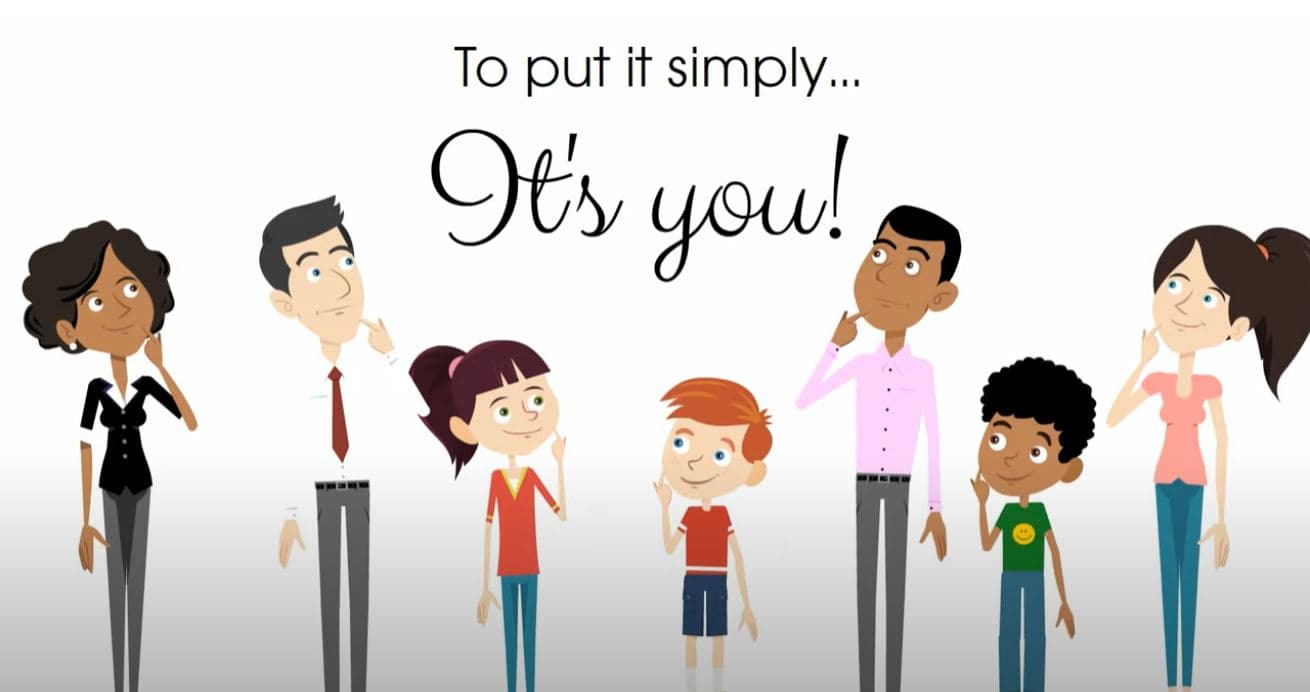
Before launching your lesson, warm things up with this 3-minute video that walks students through the meaning of writer’s voice. It includes quotes from children’s books followed by quick discussion questions.
(Runtime: 3:26 – perfect for bell ringer or mid-lesson switch-up.)
Characters with Clear Voice
Narrative writing brings voice to life—especially when authors switch perspectives. Two characters. Two styles. Same age. Totally different sound.
Tom Sawyer (age 12, 1875)
“Hi-yi! You’re up a stump, ain’t you!”
Anne of Green Gables (age 11, 1907)
“It blooms as if it meant it—but I meant everything… the garden and the orchard and the brook and the woods…”
Let students compare:
- sentence length
- grammar
- figurative phrases
- handling emotions
Voice isn’t just what the character says—it’s how they say it.
🎤 Writer’s Voice on TV: Ed Sheeran & Ketchup

Need a real-world example? Pop in Ed Sheeran’s Heinz ketchup commercial.
Sheeran’s voice is charmingly casual:
- says “Yeap” instead of “Yes”
- skips fancy words for “blah blah blah”
- makes a high-end restaurant feel like a snack shack
(Great discussion starter or modeling piece for writing tone.)
✏️ Classroom Activities
The handout includes printables for these activities with student pages and answer keys.
Activity 1: Character Voices in Literature
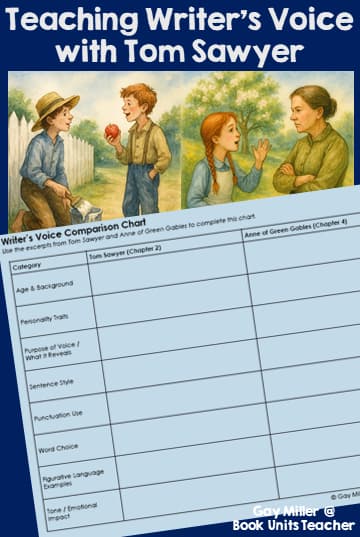
Using mentor texts to compare characters is an effective way for students to develop this important skill. The handout includes short excerpts from Tom Sawyer and Anne of Green Gables, followed by a comparison chart for students to complete.
Activity 2: Commercial Commentary
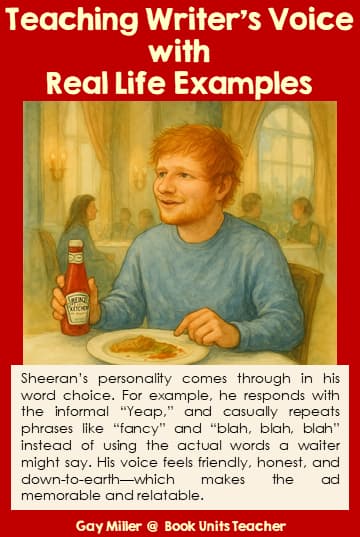
Have students watch the Heinz ad and describe Sheeran’s voice. Is it humble? Confident? Silly?
Activity 3: Quote Dissection
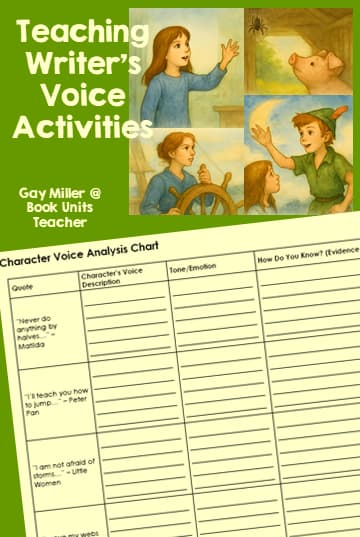
The handout includes four quotes from children’s literature for students to analyze and uncover the character’s voice, with a comparison chart for students to complete as they examine the quotes.
“Be outrageous. Go the whole hog.” – Matilda
“I’ll teach you how to jump on the wind’s back.” – Peter Pan
Ask students:
- What tone do these quotes carry?
- Would these characters write formal essays the same way?
Quick Tips for Building Voice in Student Writing
Encourage students to shape voice by thinking about:
- age, location, and background of character
- personality traits (shy, bold, dramatic)
- purpose of writing (to entertain? to reflect?)
- sentence style and punctuation choices
 Ready-to-Go Toolkit
Ready-to-Go Toolkit
The blog gives your teaching voice. The printable handout brings it into the classroom.
Includes:
- mentor text passages
- quick analysis prompts
- video reflection questions
- comparison charts
- quote dissection worksheet
You’ve got the lesson, the printable., and even got Ed Sheeran talking ketchup.
 ,
,See the product that inspired this post.

If you are looking to add some high interest activities to your lessons, try using animated shorts to teach reading and writing skills. This packet contains graphic organizers covering many Common Core skills. $Save$ when you purchase this mega bundle which includes all 12 units.
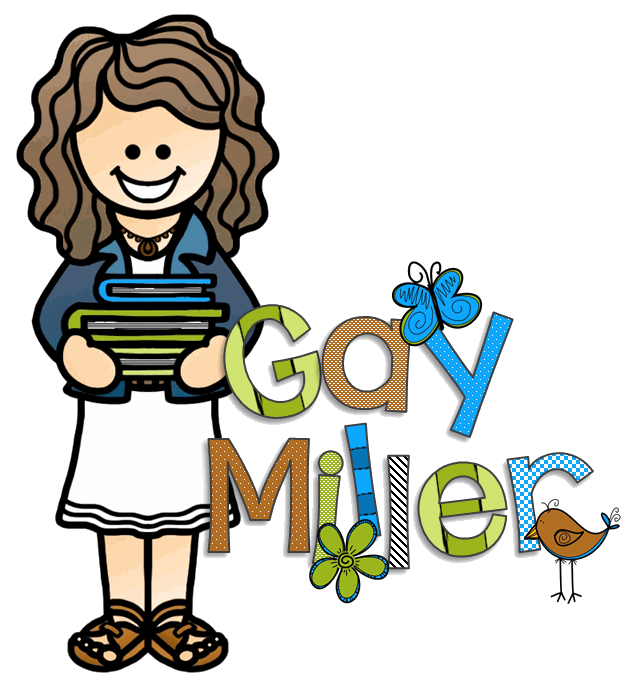


1 comment
Hey there! I’ve been following your blog for some time now and finally got the courage to go
ahead and give you a shout out from Huffman Texas!
Just wanted to tell you keep up the great job!